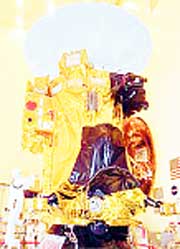NASA returns to developing nuclear propulsion and energy supply systems for its spacecraft. This time, the systems will only be activated when they are at a safe distance from Earth
Warren Leary New York Times

Years after almost completely abandoning efforts to use nuclear energy in space, NASA announced a few days ago a "Nuclear Systems Initiative", which it says could give the necessary boost to space exploration within a decade. Hidden within the Bush administration's proposed budget for 2003 for the space agency is 125.5 million dollars intended for this very purpose.
In the early days of the space program, NASA tested nuclear-powered rockets as a possible means of sending humans to Mars and other planets. The agency conducted experiments with several nuclear rocket engines, but abandoned the effort because no missions suitable for their use were in sight. In the new plan, nuclear reactors would not be responsible for the initial thrust to propel the rockets, as in the earlier plan, but would only be operated at a distance from Earth, to provide energy for other types of engines.
The agency also developed electricity generators, the energy for their operation is provided by radioactive materials, which were flown on about twenty spacecraft - including the research spacecraft "Pioneer" and "Vager" to the distant planets and the manned "Apollo" missions to the moon. In 1997, the launch of another research spacecraft with a nuclear power generator, the "Cassini" mission to Saturn, drew protests from environmental organizations and organizations opposed to the use of nuclear energy, who feared that the explosion of the rocket could spread radioactivity.
Now only one of these electricity generators, called RTG (radioisotope thermoelectric generators), remains in the civilian space exploration inventory, and according to NASA officials, it is time to reopen the production lines. The new program, they say, offers an opportunity to design and build more efficient power generators that require less nuclear fuel and can be used in more types of spacecraft.
NASA proposes to spend 950 million dollars in the next five years to develop new types of electricity generators powered by nuclear energy to provide electricity to spaceships, and also to build rockets that operate using nuclear-produced electricity to propel spaceships at greater speed.
The head of NASA, Sean O'Keefe, said that nuclear energy will help the organizers of research trips in space "to overcome the problems of distance and time". According to him, the continuation of research journeys in the solar system and in the space beyond it is hindered by the limitations of propulsion using conventional chemical rockets, as well as by the limitations that exist today regarding the ability to provide the necessary electricity for the entire length of the spaceship's journey - a supply that is carried out mainly through solar cells for energy production.
Officials said the nuclear program would be run in partnership with the US Department of Energy, which has the facilities and expertise to build nuclear power generators. Earl Wallquist, from the Department of Propulsion Systems for Space and Defense at the Ministry of Energy, said that the fuel that was usually used in the RTG units, plutonium-238, is no longer produced in the United States. Wohlquist said his office would use NASA funds to buy the needed plutonium from Russia.
Dr. Edward Weiler, head of the space science department at NASA, said that nuclear power generators are necessary for missions to the distant planets, where sunlight is weak. But he believes that the new nuclear power generators could also revolutionize the study of nearby planets. The Smart Lander mission to Mars, which was scheduled for launch in 2007, will be delayed by two years to convert it from a solar-powered lander to one powered by a nuclear power generator. According to him, for about the same cost, the 180-day mission, powered by solar energy, could be stretched to 1,000 days using nuclear energy, and the machine would be able to cover a range of up to about 80 km instead of about 5-2 km, firing for signs Haim.
In order to propel a spaceship, it is possible to use a nuclear reactor as a source of energy to operate new types of engines, such as the ion engine that was recently successfully used in the Deep Space 1 mission. This spacecraft used solar energy to operate an engine, which pushed it continuously and slowly to high speeds. A nuclear-powered ion engine could bring a spacecraft to Pluto in half the time it takes to do it using existing rockets, Dr. Weiler said.
NASA officials said the systems they envision would be launched using conventional rockets and would not be activated until they were safely in space. After they are activated, they said, they will not leave any traces of radiation.
Nevertheless, there is some opposition to the initiative. "and Nuclear Power in Space," Network Against Weapons The Global, a Florida-based organization, said it remained opposed to any nuclear systems in space and speculated that any new technology developed could be applied to military uses.
